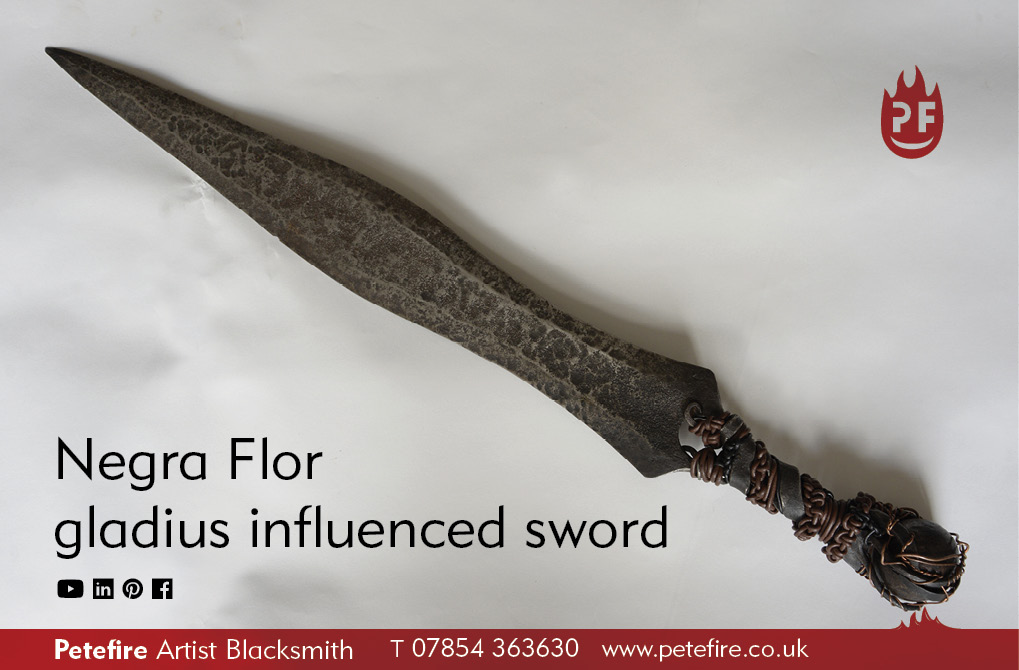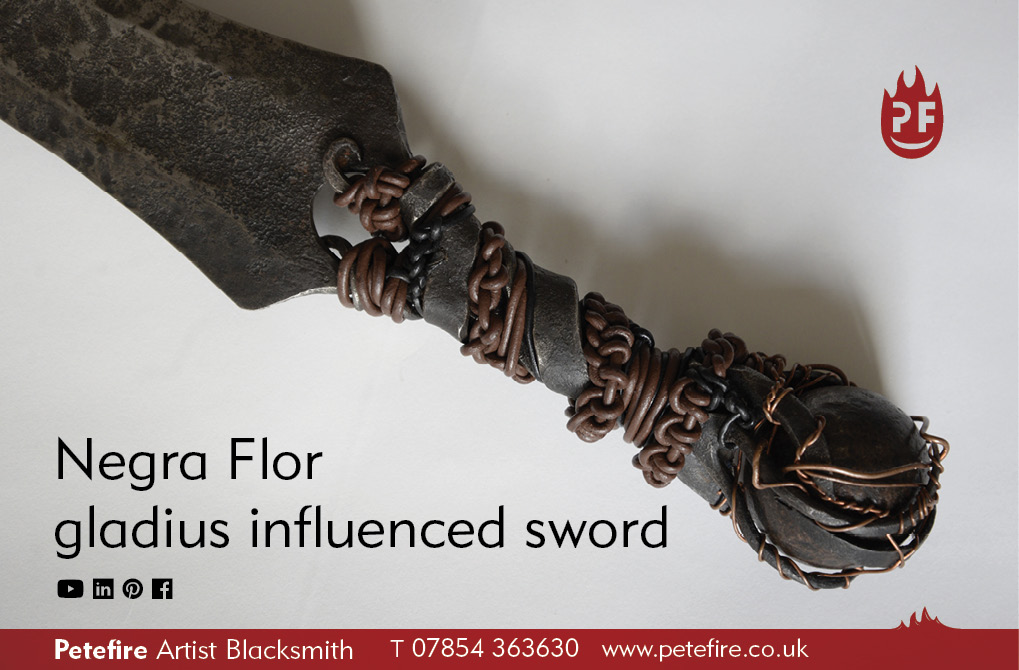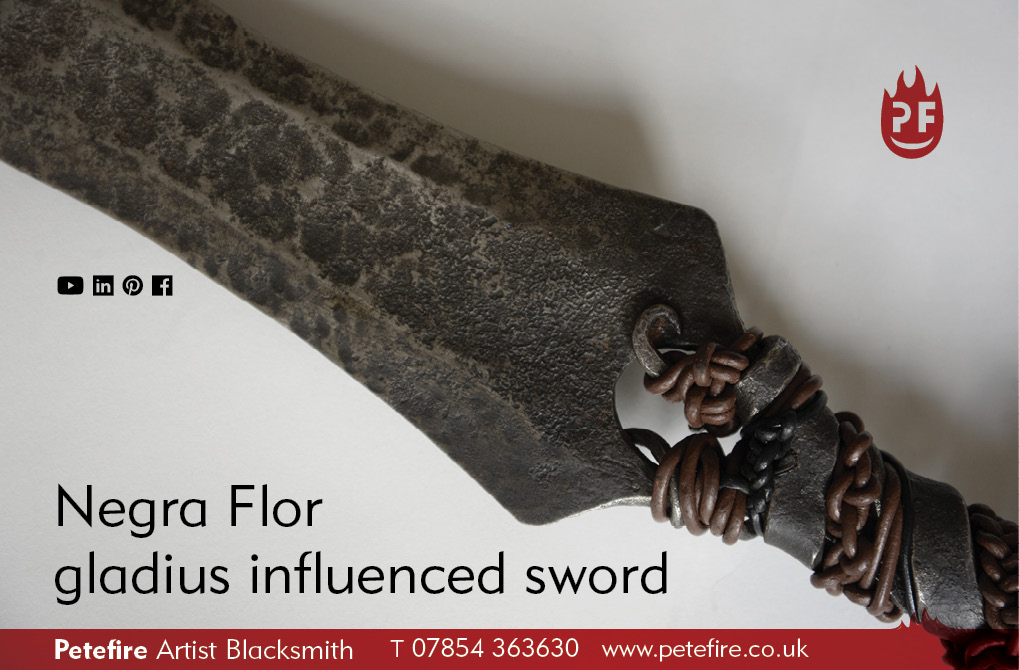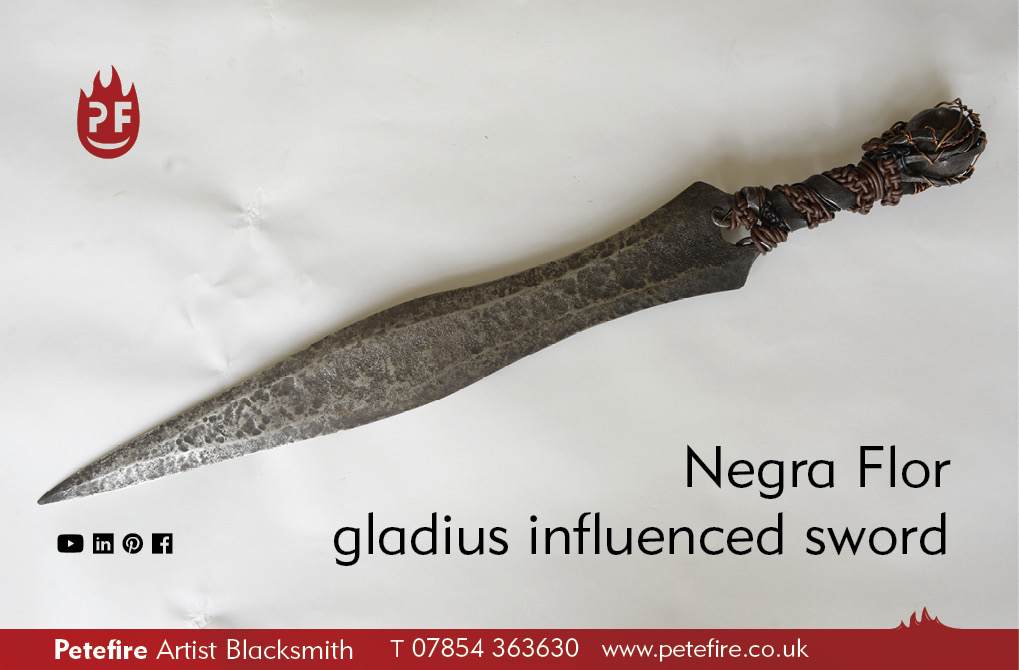Peter talks about one of his designs, a hand-forged Roman gladius influenced sword, also influenced by bronze age sword styles
The name of this piece is Negra Flor, which is Portuguese for black flower. I really like how the name sounds, and i think it adds more to the name than just black flower. It’s called that because the counterweight ball on the end is wrapped around a forged flower shape, like the petals of a flower, the flower is growing up out of the ground, so it’s more like roots coming up out of a ball. It almost looks like the sword is being pulled up out of the ground, in some kind of plant in the rain forest, as if the flower and the bulb is being left to dry out – but made from a piece of steel which gives it more romance.
So what are the influences on this sword?
The styling of the shape itself, originally comes down to a bronze age sword. It’s physics and proportions are thinner in some areas, and thicker in some areas. In some ways it is a take on a gladius, with the proportions of a gladius, unlike a gladius, it’s made out of modern steels – recycled steels, this was actually a car leaf spring.
It was forged out with the intention of getting the finish possible and to actually take the true proportions into account in the forging, so the actual tip is much heaver than the actual round bit of the blade has the straightened face, below that again in the lower part of the leaf it’s thicker again, it would be much better for defending with.
What does ‘true proportions’ mean?
True proportions is like not having just one straight bar of steel which is basically just one length, weight proportions throughout which make it’s movements and ergonomics much more graceful, and makes for a nicer movement, and that’s the whole purpose of having the ball on it.
So it adds balance to it?
Yes, the ball gives balance to it, the scrolls are put in such a place on the balance point that they can be pinched with the finger and the thumb, when the sword points forward. I’m not overly guiding this at the moment, but it sits like this (pointing forward) because of the proportions of the sword, if it was a gladiator’s gladious or even fencing sword it naturally points forward so it’s always on the defensive – offensive, but the idea of the ball is that it’s very good for sword dancing with and the proportions lend themselves quite nicely to that, the weight of it, having the guard up here means your hand doesn’t slide down it. Because I’ve forged it so much for the finish and filed off any excess that’s splurged out into the cutting edge that’s meant that it’s got a flat edge to it, so it’s not actually sharp so to use it for juggling purposes creates quite a nice prop to actually play around with because you can hold onto the blade – should you really wish – and not cut yourself. at the same time if you hit it into a log, because of it’s shape it would cut into it.
What percentage of it it blacksmith forged, and what percentage is ground?
About 97% is forged, only around 3% isn’t forged, even the tip is forged. It’s forged to a flat round tip and it’s just brushing off the edge, there’s no stock removal, apart from the lightest bit of sanding and a little bit of filing on the edge. The blade is not dead straight but then the reason for this is that it is one of the first of its kind for me, forging these kind of in-bevels and forging the proportions of the blade so its got the edge that has two ridges, it’s kind of copying a bronze age style, although the bronze age could never have achieved this as the bronze age sword would have been heavier and would have had a longer heavier ridge down the middle of it, as the metal was softer and the modern blades would be much sharper, this was inspired by using steel which is much stronger so it can be thinner.
It’s really pliable
It has an amount of pliability to it because it needs it, the sword was heat treated on a coal fire with what I call ‘clean embers’ – they are coals that have burned off all the black soot from the coal and the actual embers, and you make sure that they’re actual embers, you nurse that for a little while until you’ve got a pile of them, then using the ash which has tiny little bits of coal in it which can create something that I call liquid fire, you can push the sword into the ash and pull it out again so you can slowly build up the heat, developing a much nicer temperature on the steel, where you get a very hot edge but the core of it is not too hot, then you use the back bosh (the back bosh is the water tank that connects up to the tub which is the pipe which feed the oxygen into the fire, the water at the back gets hot, because it’s always around the tue iron to stop it from crumbling, it’s weird thing in physics where the water being in there stops the clay from crumbling. The water gets really hot – almost a constant boiling temperature, so if I take the sword and heat up the edges of it to try to keep the inner core colder as the edges are constantly running up against the coals they are maintaining their heat by being pushed into the ash further along, so using the ash to your advantage in the heat treating, you get the heat up and quench it in the hot water and ultimately often with things like an axe or a hammer you’d want to temper it back, but with a lot of sword I wouldn’t actually temper them, that would be their heat treatment, so this has still got some flex to it but it’s quite thick in it outer edges but I don’t think I actually tempered this one, sometimes I’ll just leave it on top of the coals and take it up to a temper that way, you can see a slight yellow on this sword, this one was done in this way. You then need to polish up the blade with some sandpaper and then you just place it on top of the coals, running it slowly along the coals, that will slowly add the temper colours.
What is the string around the ball made from?
It’s actual handle string, that came from a katana that I bought a few years back and I dismantled that one. I could also have used some leather cord.
Is the ball separate from the housing?
At one point I had it freely rotating, with the petals spring-fit around it, they don’t really hold it in place so the string is necessary as it makes everything torque together. I chose to add the string after I hit a log and the ball bounced out.
How many millimetres clearance is there between the ball and the petals?
There’s less than a millimetre in some places, around a millimetre in other places, it’s quite well locked in place, all of it’s bases of movement are covered, the string just helps to keep it in place, which makes it feel better as well.
How was the hole at the top of the blade made?
It was hot punched and drifted out and then forged around about the rest of it. The hole ends up creating the mechanism were the vines can lock into, which makes a nice feature.
So what would you say to summarise the Negra Floure sword?
To summarise this sword, I would say that it was possibly one of the first swords that I ever forged and it’s one of my favourite swords to play with, as an item. This kind of thing as a style it’s quite replicable in the idea that you could forge it solid, so you take a solid bit of steel and forge out the blade then you forge the handle and you can get the same proportions out of that solid volume of steel without doing this is something I really want to look at. I think it’s a great ‘first of it’s kind’, it’s a great prototype, I think really it’s prop worthy in terms of it’s functionality.
As in, it could be in a film?
Yes, that kind of thing, like it could be impacted with – as in steel on steel in the fight scene.
Do you mean that it wouldn’t shatter?
Yes, as a training for this edge geometry I think it was a great success.





